| |
Abstract
Objectives: This study aims to study determinants for the control of diabetes and hypertension in Al Ain Ambulatory Healthcare patients.
Method: This is a cross sectional observational study of patients attending ambulatory healthcare centers in Al Ain, United Arab Emirates in 2009. From a yearly audit evaluating the care of patients with diabetes and hypertension, the determinants for improved diabetes and hypertension outcomes were identified from a total of 512 patients and its association with glycemic and blood pressure control were studied.
Results: From all variables studied, only the clinic where the patient was treated helped predict both improved blood sugar and blood pressure control. For patients with diabetes, poor control the year before (p<0.001), the number of chronic disease clinic visits (p=0.042) and triglyceride levels (p=0.007) predicted worse control of diabetes. A predictor of poor control of blood pressure (p<0.001) for patients with hypertension was poor control of blood pressure in the year before.
Conclusion: In this population, the healthcare system and the team played major roles as determinants in the control of patient’s diabetes and blood pressure more than any of the other factors examined.
Keywords: Diabetes; Hypertension; Quality Care.
Introduction
Poor control of diabetes and hypertension contributes to significant cardiovascular morbidity and mortality,1 and improving control of both has been found very effective in reducing these endpoints.2 Determinants of control in diabetes and hypertension are an area in which research is lacking probably due to numerous determining factors that interact and influence many outcomes of the disease. Data from a few studies that have examined this area may not be very informative because most of the factors that determine better control of a disease are dependent on specific variables, such as the country and population studied.3 Also, factors such as healthcare delivery systems, co-morbidities and cultural and socioeconomic factors vary from one country to another. Therefore, identifying specific factors for each disease will help improve patients' outcomes.
This study’s main objective was to study the determinants for the control of diabetes and hypertension among Al Ain Ambulatory Healthcare patients in order to identify patient characteristics that predict poor diabetes or hypertension control and help to design better healthcare for these conditions. This study examined factors that are hypothesized to affect the outcome of diabetic and hypertensive care and, while many of these variables were also found in other studies,3-10 new variables are also included. These factors were obtained from care audit conducted as part of a chronic care program in Al Ain, United Arab Emirates (UAE), where improved diabetes and hypertension control was shown.11 The study population consisted of patients attending chronic disease management clinics set up in seven primary healthcare centres (PHCC) in Al Ain, UAE. Some of the factors included are modifiable factors that have the potential for improvement of disease outcomes through better care practices.
Method
The population of diabetic and hypertensive patients in this study came from seven primary healthcare centres with daily chronic disease clinics located in Al Ain, United Arab Emirates. In Al Ain, government ambulatory healthcare centers are known to be the main healthcare providers for the nationals since it is best equipped and covering all catchment areas, rural and urban, and free. Diabetes and hypertension forms 5% and 6%, respectively, of total center visits with average annual number of visits of 15,119 and 16,001, correspondingly, with a total annual number of 31,120 visits.
This report is a cross sectional observational study of patients attending ambulatory healthcare centers in Al Ain, United Arab Emirates in 2009. From a yearly audit evaluating the care of patients with diabetes and hypertension, possible determinants for improved diabetes and hypertension outcomes were identified from a total of 512 patients and its association with glycemic and blood pressure control were studied. The data source was the annual audit of patients with diabetes and hypertension registered in the chronic care program at seven Al Ain primary healthcare centres. The audit was done by a team of nurses who rotate over one to two months in all centers and extract needed data from the medical records. The number of records audited was determined by the size of the center with a total of around 100 patients for large centers, and for medium-sized centers 60-80 patients targeted. The attendances for large, medium, and small centers were 250-300, 150- 200 and 100-150 patients per day, respectively. A sample was extracted from the appointment books of patients attending in the three-month period prior to the audit. The audit monitored the care of persons with diabetes and hypertension in these centres and included 512 patient chart reviews conducted in 2009. The methodology has been described in details elsewhere.11
The determinants assessed (Table 1) consisted of all factors surveyed in the audit that had the potential to influence better outcomes of care such as HBA1C, TG, chronic disease visit, age, sex, date of diagnosis of diabetes and hypertension, waist circumference, Body Mass Index (BMI), FBS, RBS, total cholesterol, HDL, LDL, number of hypertension medications, number of diabetes medication, on aspirin, on statin, center visit, systolic blood pressure, diastolic blood pressure, hypertension, on insulin. These included those relating to the healthcare system, resources available, the patients or their diseases. Other factors assessed included age, gender, duration of illness, BMI, lipid profile, number of medications, and number of visits to the centre. For statistical analysis, linear regression was used to test the influence of the different factors on the outcomes studied.
Results
Although many factors were examined as possibly determining better diabetic or hypertensive outcomes in this population, less than a handful emerged as final determinants. Factors with predictions of significantly improved control of these outcomes are shown in Tables 2, 3 and 4. One factor for improved control of both hypertension and diabetes is the healthcare centre the patient attended. One of these centres (MQ) was significantly better in diabetic and blood pressure control (p<0.001) than other centres. All other factors listed in Table 1 were not found as significant determinants for better control of these diseases in this population.
In patients with diabetes, another healthcare system-related factor emerged as significant; the number of visits to the chronic disease clinics (p=0.04). This was part of an intervention for the improvement of diabetes care in these centres. However, this factor was not significant for the patients with hypertension. In addition, elevated HbA1c in the previous year was a significant predictor of poor control of diabetes (p<0.001), although fasting blood glucose (FBG) and random blood sugar (RBG) measurements were not significant predictors (Table 2). Triglyceride levels were also found directly related to diabetic control (p=0.007).
Upon examination for predictors of improved control in hypertensive patients, elevated diastolic and systolic blood pressure taken the previous year were significantly predictive (p<0.001) (Tables 3 and 4). No other predictors of poor hypertensive control were determined for this population. It was also investigated if obesity was predicted by any of the other factors studied in patients with these two disease states. Waist circumference and BMI are highly associated with obesity. As shown in Table 5, age and gender were found to be predictors of high BMI but not increased waist circumference. Also, younger females were more likely to have a higher BMI, and obesity was not predicted by any of the other factors studied in these disease states.
Table 1: Variables studied categorized as healthcare system, healthcare professional, disease or patient-related.
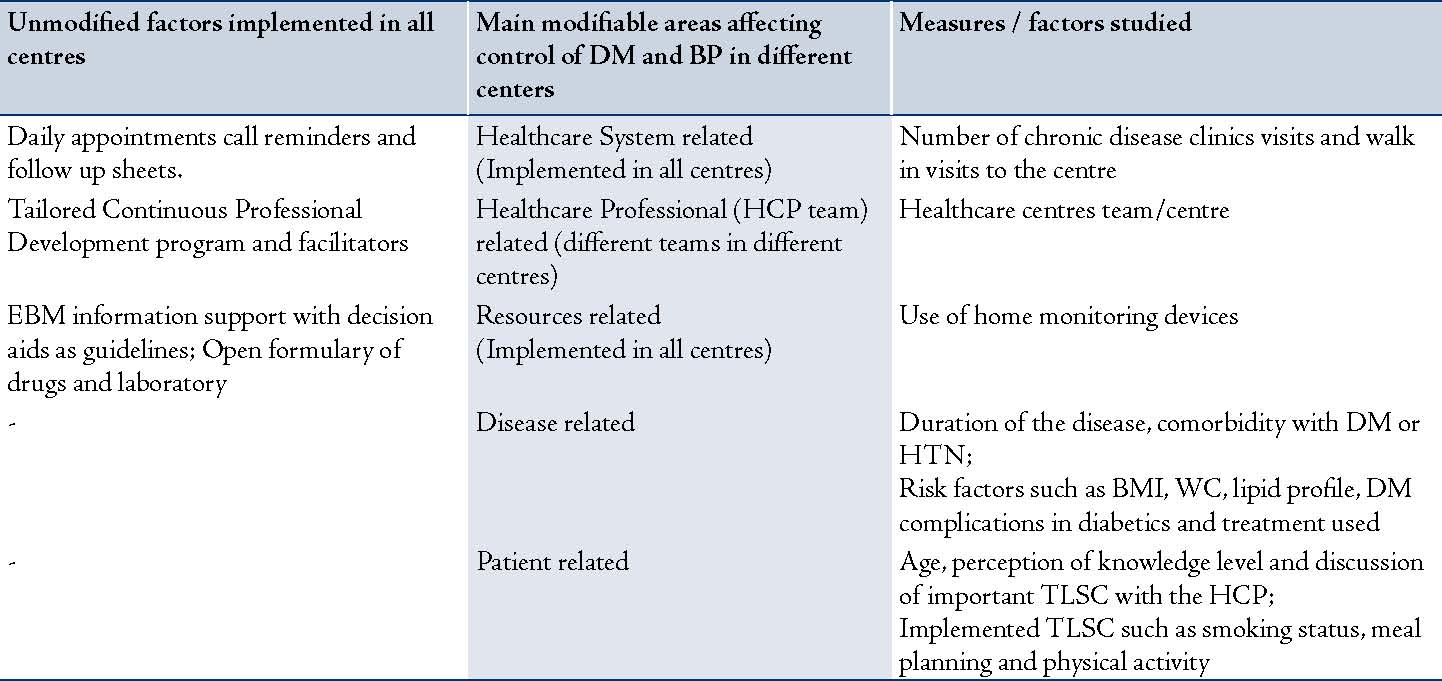
Table 2: Regression analysis of patient-related factors showing significant predictors of HbA1C in 2009 (p>0.05).
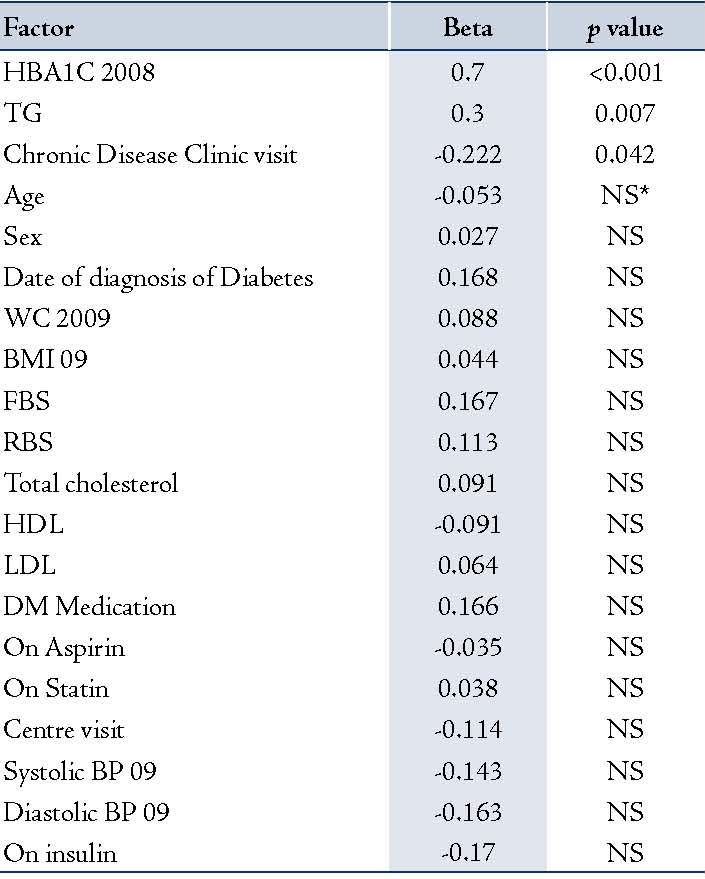
Table 3: Regression analysis of patient-related factors showing significant predictors of systolic blood pressure in 2009 (p>0.05).
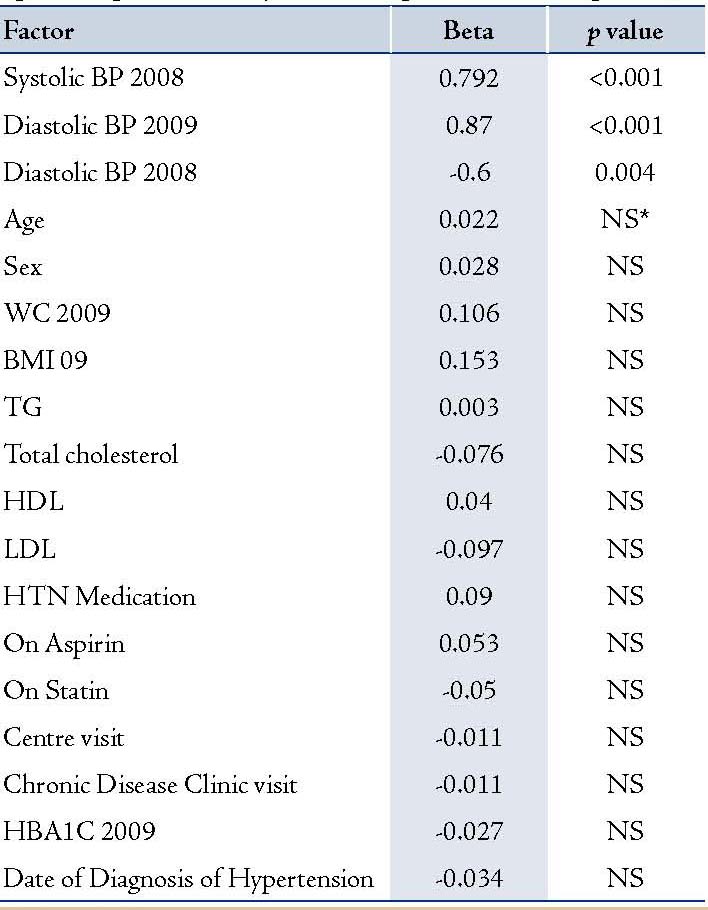
Table 4: Regression analysis of patient-related factors showing significant predictors of diastolic blood pressure in 2009 (p>0.05).
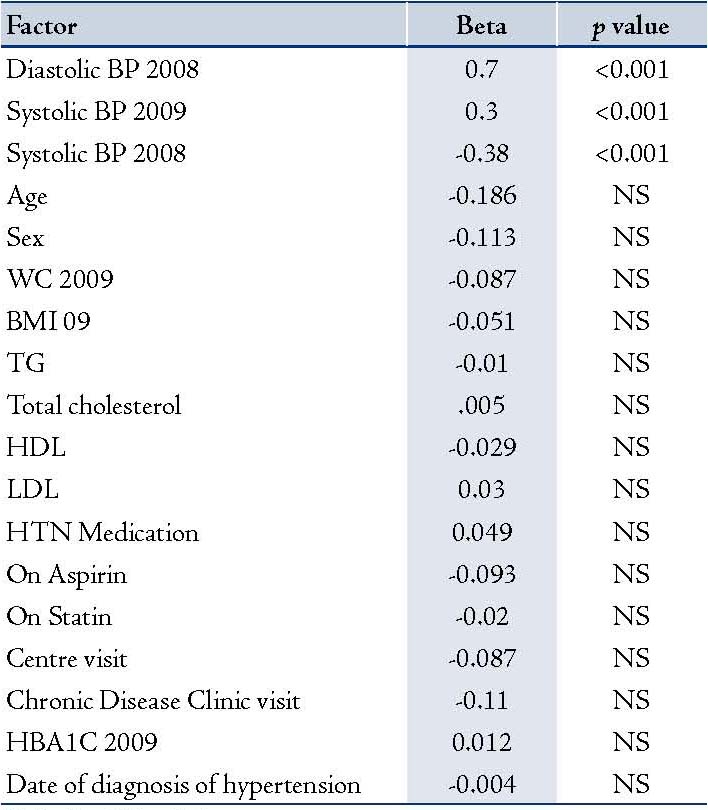
Table 5: Regression analyses of the factors contributing to body mass index and waist circumference.

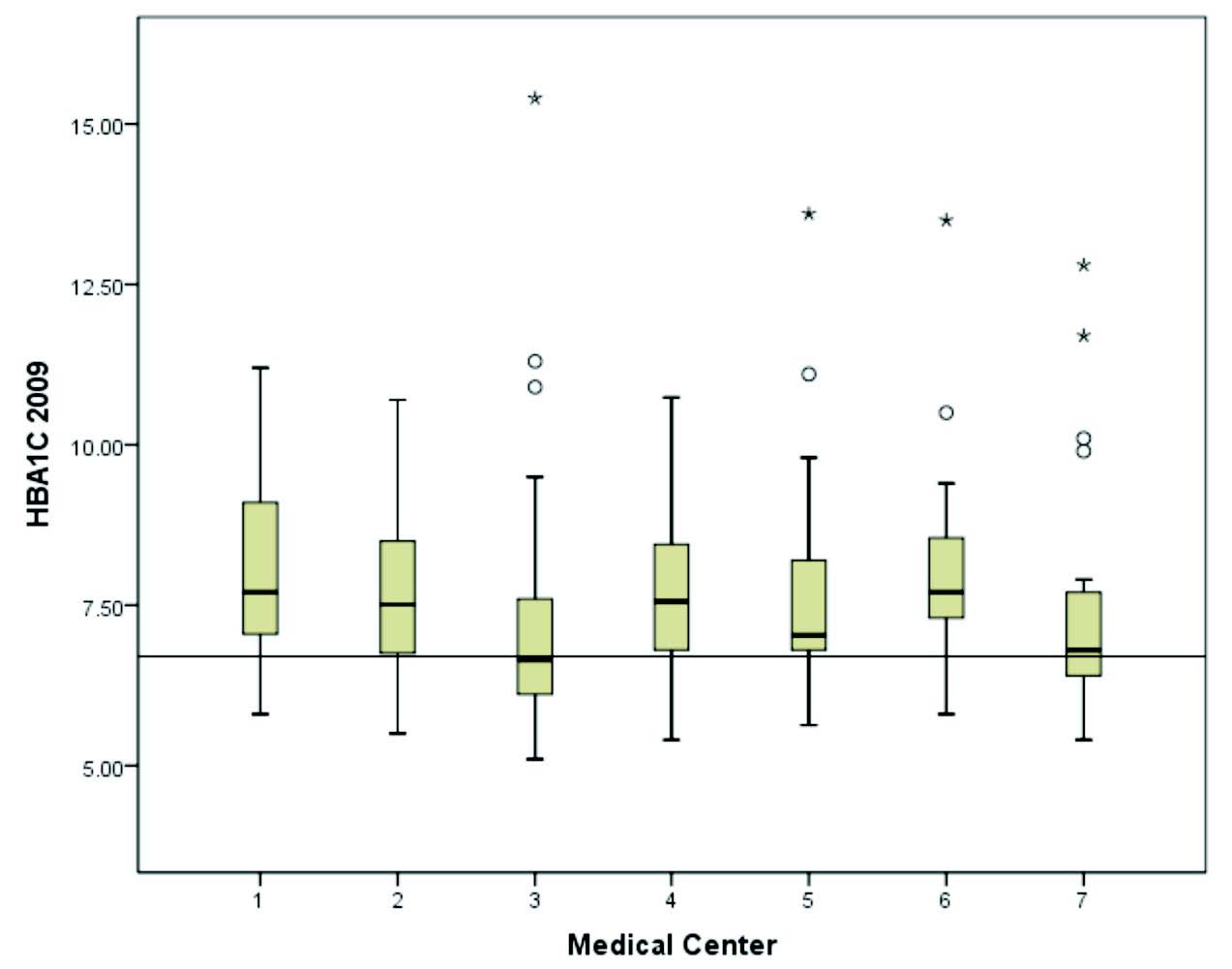
Figure 1: Diabetes control (mean HbA1C) of patients with diabetes attending the seven Ambulatory Healthcare centers.
Healthcare centers showed significant differences regarding diabetes and hypertension control. Center 3 predominantly showed better care parameters and center 1 showed worse control. For example, center 3's mean HbA1C was 7 while for center 1 it was more than 8. The other centers were in between as shown in Figs. 1 and 2. Regression analysis also showed that the healthcare center is a significant predictor of diabetes and hypertension control.
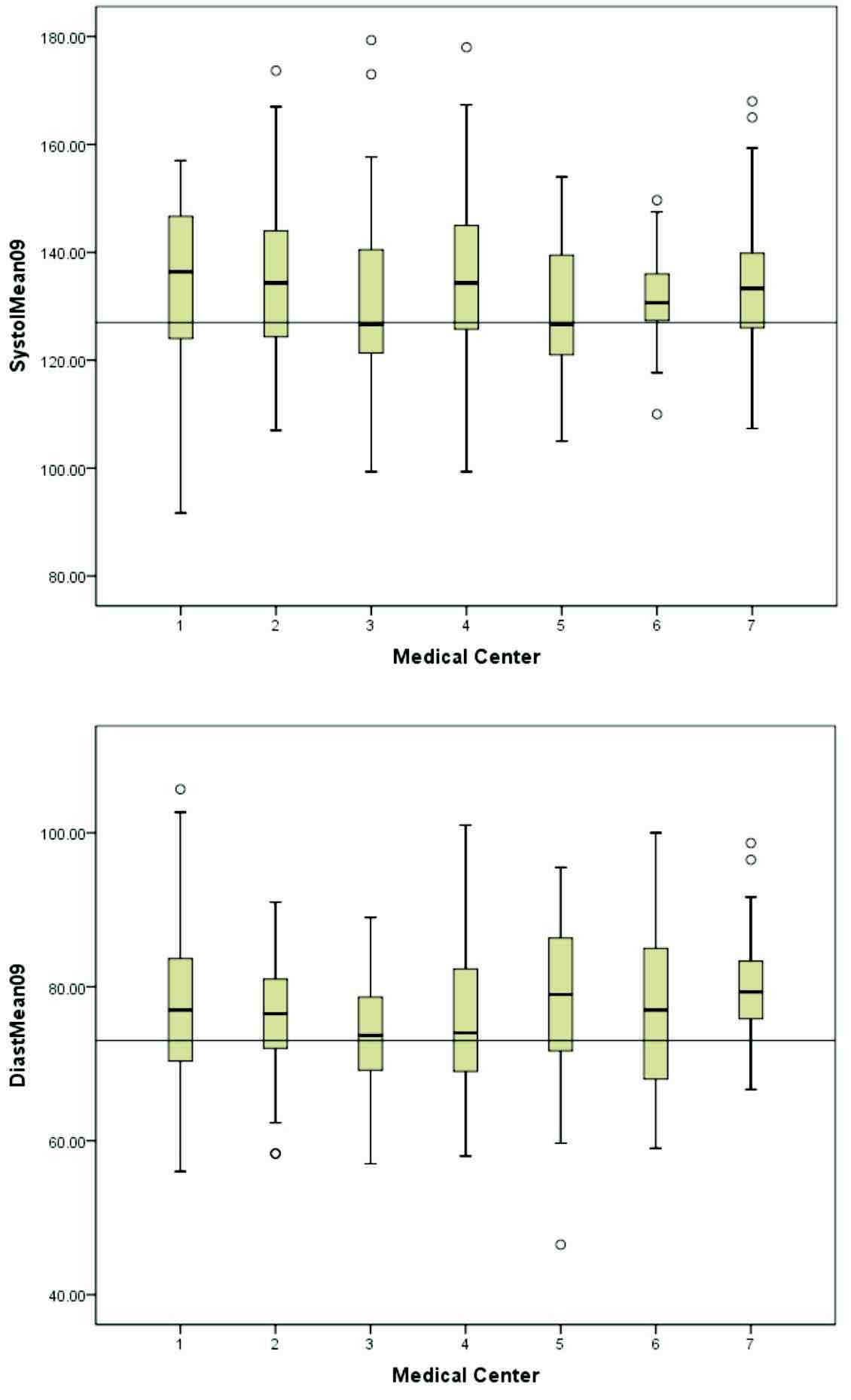
Figure 2: Hypertension control (mean Diastolic and Systolic blood pressure) of patients with hypertension attending the seven Ambulatory Healthcare centers.
Discussion
Among the determinants assessed for better control of diabetic and hypertensive patients attending primary healthcare centres in Al Ain, those relating to the healthcare team were found to be most important, not factors relating to the patient or the disease itself. The most important determinant for improved control of these diseases was the centre the patient attended; however, similar resources are available in all health centres and all are managed under the same administration in this area. The number of visits to the designated clinics showed significant prediction for improved control of diabetes but not for hypertension, suggesting an area for future studies. Perhaps, monitoring patients leads to more visits and consequently better control of their disease because 66% of the diabetic population had glucometers, yet only 10% of the hypertensive patients had blood pressure monitoring devices.12
Few studies investigating determinants of the control of hypertension and diabetics in patients are currently available. Of those available, unlike this study, many factors were found as predictors of worse control of these two diseases.3-5 These included FBS, higher blood glucose at diagnosis, higher triglyceride and total cholesterol levels, and younger age. In another study, predictors of improved control included female sex, lower systolic blood pressure (SBP) level, lower triglyceride (TG) level, lower urine albumin level, higher LDL cholesterol, less intensive treatment for type 2 diabetes, dyslipidemia and antiplatelets, and lower cerebrovascular reactivity.
For type 1 diabetic patients, participating in an intensified treatment and teaching programme, HbA1 values before the intervention, smoking, diabetes-related knowledge, home blood glucose monitoring, age at onset of diabetes, perceived coping abilities and C-peptide levels were among important determinants in predicting control of this disease.13 As found in the present study also, the baseline HbA1C values in predicting control in diabetes is important. Similarly for hypertension, baseline blood pressure values were the only predictors of control among all of the studied factors in this present study; however, others have found other patient-related factors are of importance as well in predicting hypertension control such as sex and ethnicity.14
A number of studies have shown the effect of healthcare system and healthcare team as predictors for improved control of diabetes and hypertension, similar to the current study.15-17 A study of African patients monitored by physicians from 1991 to 2004 in Cote d'Ivoire Healthcare showed healthcare system-related parameters such as frequency of visits and duration of monitoring to be effective for improved control of diabetes and hypertension.17 Furthermore, influence of the healthcare team was found to have a similar effect in another study,6 where the primary care physician was the most significant predictor of improved diabetic control, even though this study had fewer patients with lower socioeconomic status and more men than the present study; thus, suggests that the primary care physician has an important role in the patient achieving proper diabetes control. In this present study, all PHCCs were part of a quality improvement project; however, the impact that one centre made on these patients was not related to resources or staffing. Centres are equally equipped and their goal is to improve the care of diabetic and hypertensive patients. Also, all staffs were general practitioners and nurses who very rarely had a postgraduate degree recruited by the same managing team. When one centre stands above the rest, the difference in quality of care is probably based on the centre’s team function and individual capabilities; however, this will need further study.
This study provides answers to questions clinicians are faced with regarding patients with poor control of their diabetes and/or hypertension. The lack of association of poor control with traditionally thought factors could be due to the presence of other unstudied factors such as educational, psychological, home support or others that may be better investigated through a qualitative study design.18 Potential contributing factors for poor control were provided in this study, and perhaps adjusting such factors will contribute to improvements. This study also helps to clarify the role of such factors such as diabetes duration, dyslipidemia and obesity as determinants for better control of these two diseases. Healthcare cost saving in better performing centers is another important drive to investigate as well, in addition to the quality of life of patients. In a recent study in Al Ain, there was a big difference in the cost of caring for diabetic with no complications to those with complications.
Limitations of this study include the lack of coverage of other factors that may be determinants of control in diabetes and hypertension. Such factors may include the following: socioeconomic status, knowledge of both diseases, comorbidities, and medications that patients may be taking that may affect the outcome of their disease control. Nevertheless, a reflection of the main areas of control is highlighted in this study. Future research should explore other possible determinants for better outcomes. Currently, two other studies are investigating the relation between knowledge and diabetes control, and the psychological aspects of control in persons with diabetes in the UAE. For healthcare policy makers, the emphasis on healthcare professionals and their team structure is of paramount importance. More research is needed to investigate factors contributing to high or low performance in the health centres so that appropriate measures for quality care can be implemented. A study conducted in the United States found that programs associated with better diabetes control have teams that actively involve physicians in quality improvement, use electronic health information systems, have authority to respond to staffing and programmatic issues, and engage patients in care.19 Additionally, emphasis on self-management programs that focus on even brief counseling are promising.20
Conclusion
The studied diseases and patients’ characteristics did not predict poor diabetes or hypertension control in this population. The healthcare system has emerged as a key determinant for better outcomes, highlighting the need to assess the relevant healthcare systems in search for improved patient care.
Acknowledgements
The authors reported no conflict of interests and no funding was received for this work.
References
1. Holman RR, Paul SK, Bethel MA, Matthews DR, Neil HA. 10-year follow-up of intensive glucose control in type 2 diabetes. N Engl J Med 2008 Oct;359(15):1577-1589.
2. Gudmundsson LS, Johannsson M, Thorgeirsson G, Sigfusson N, Sigvaldason H, Witteman JC. Hypertension control as predictor of mortality in treated men and women, followed for up to 30 years. Cardiovasc Drugs Ther 2005 May;19(3):227-235.
3. Chan JC, Gagliardino JJ, Baik SH, Chantelot JM, Ferreira SR, Hancu N, et al; IDMPS Investigators. Multifaceted determinants for achieving glycemic control: the International Diabetes Management Practice Study (IDMPS). Diabetes Care 2009 Feb;32(2):227-233.
4. Duggirala MK, Cuddihy RM, Cuddihy MT, Naessens JM, Cha SS, Mandrekar JN, et al. Predictors of blood pressure control in patients with diabetes and hypertension seen in primary care clinics. Am J Hypertens 2005 Jun;18(6):833-838.
5. Goudswaard AN, Stolk RP, Zuithoff P, Rutten GE. Patient characteristics do not predict poor glycaemic control in type 2 diabetes patients treated in primary care. Eur J Epidemiol 2004;19(6):541-545.
6. Mengual L, Roura P, Serra M, Montasell M, Prieto G, Bonet S. Multifactorial control and treatment intensity of type-2 diabetes in primary care settings in Catalonia. Cardiovasc Diabetol 2010;9(1):14.
7. Chew BH, Mastura I, Shariff-Ghazali S, Lee PY, Cheong AT, Ahmad Z, et al. Determinants of uncontrolled hypertension in adult type 2 diabetes mellitus: an analysis of the Malaysian diabetes registry 2009. Cardiovasc Diabetol 2012;11:54.
8. Kollannoor-Samuel G, Chhabra J, Fernandez ML, Vega-López S, Pérez SS, Damio G, et al. Determinants of fasting plasma glucose and glycosylated hemoglobin among low income Latinos with poorly controlled type 2 diabetes. J Immigr Minor Health 2011 Oct;13(5):809-817.
9. Nelson SA, Dresser GK, Vandervoort MK, Wong CJ, Feagan BG, Mahon JL, et al. Barriers to blood pressure control: a STITCH substudy. J Clin Hypertens (Greenwich) 2011 Feb;13(2):73-80.
10. Orozco-Beltran D, Brotons C, Moral I, et al. (Factors affecting the control of blood pressure and lipid levels in patients with cardiovascular disease: the PREseAP Study). Rev Esp Cardiol 2008;61:317-321.
11. Baynouna LM, Shamsan AI, Ali TA, Al Mukini LA, Al Kuwiti MH, Al Ameri TA, et al. A successful chronic care program in Al Ain-United Arab Emirates. BMC Health Serv Res 2010;10:47.
12. Baynouna LM, Nagelkerke NJ, Ali HI, Al Mukini LA, Al Ameri TA, Zein AlDeen SM. Self management Behaviours and Perceptions of Patients with Diabetes and Hypertension attending Ambulatory Health Care Services, Al Ain-United Arab Emirates. Submitted to publication 2010.
13. Bott U, Jörgens V, Grüsser M, Bender R, Mühlhauser I, Berger M. Predictors of glycaemic control in type 1 diabetic patients after participation in an intensified treatment and teaching programme. Diabet Med 1994 May;11(4):362-371.
14. Knight EL, Bohn RL, Wang PS, Glynn RJ, Mogun H, Avorn J. Predictors of uncontrolled hypertension in ambulatory patients. Hypertension 2001 Oct;38(4):809-814.
15. Shea S, Misra D, Ehrlich MH, Field L, Francis CK. Predisposing factors for severe, uncontrolled hypertension in an inner-city minority population. N Engl J Med 1992 Sep;327(11):776-781.
16. Shani M, Taylor TR, Vinker S, Lustman A, Erez R, Elhayany A, et al. Characteristics of diabetics with poor glycemic control who achieve good control. J Am Board Fam Med 2008 Nov-Dec;21(6):490-496.
17. Oga SS, Lokrou A, Tebi A, Malan AK, Papoz L, Kouadio LP. Determinants of glycaemic control in type 2 diabetes African patients monitored by physicians from 1991 to 2004 in Cote d’Ivoire. Trans R Soc Trop Med Hyg 2010 Apr;104(4):298-303.
18. Goetz K, Szecsenyi J, Campbell S, Rosemann T, Rueter G, Raum E, et al. The importance of social support for people with type 2 diabetes - a qualitative study with general practitioners, practice nurses and patients. Psychosoc Med 2012;9:Doc02.
19. Jackson GL, Yano EM, Edelman D, Krein SL, Ibrahim MA, Carey TS, et al. Veterans Affairs primary care organizational characteristics associated with better diabetes control. Am J Manag Care 2005 Apr;11(4):225-237.
20. Shawar SM, Al-Bati NA, Al-Mahameed A, Nagalla DS, Obeidat M, Al-mahameed A. Hypercholesterolemia among apparently healthy university students. Oman Med J 2012 Jul;27(4):274-280.
|